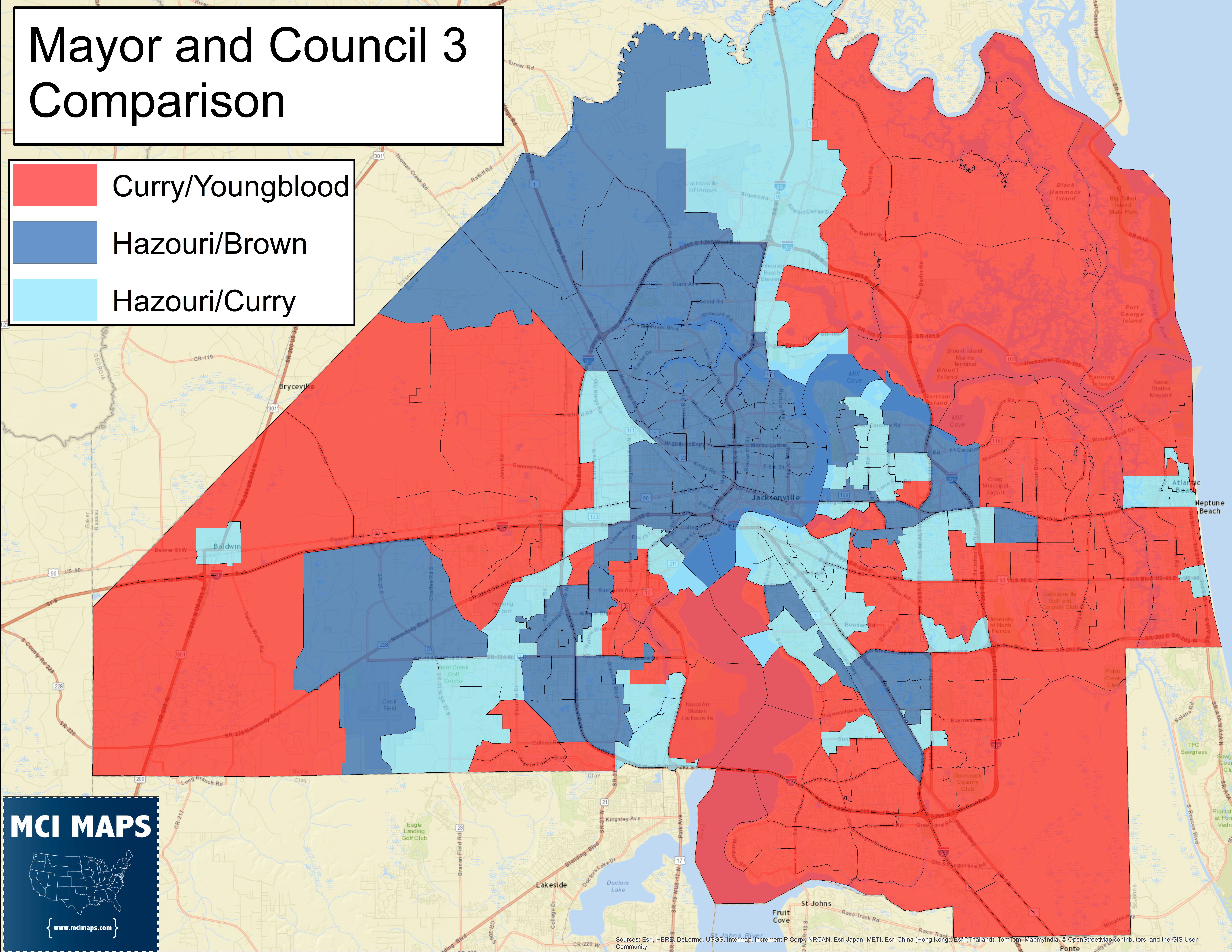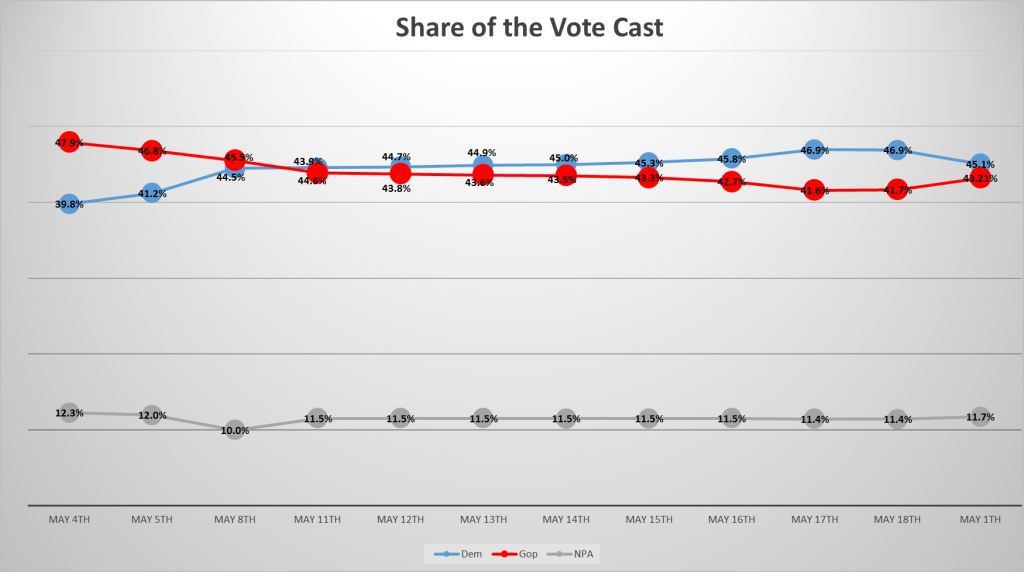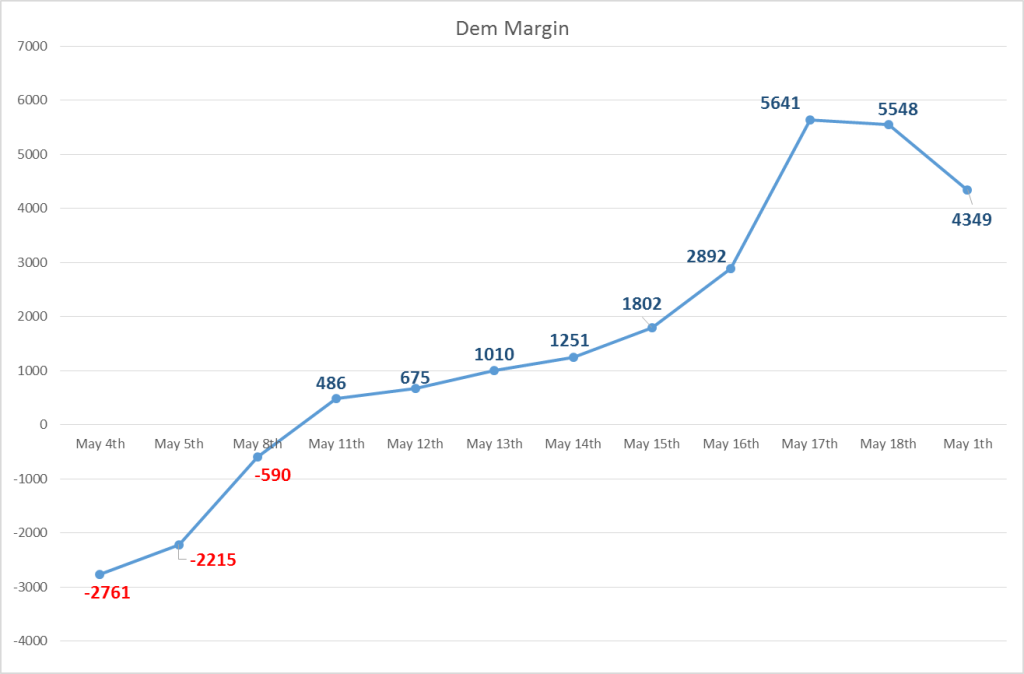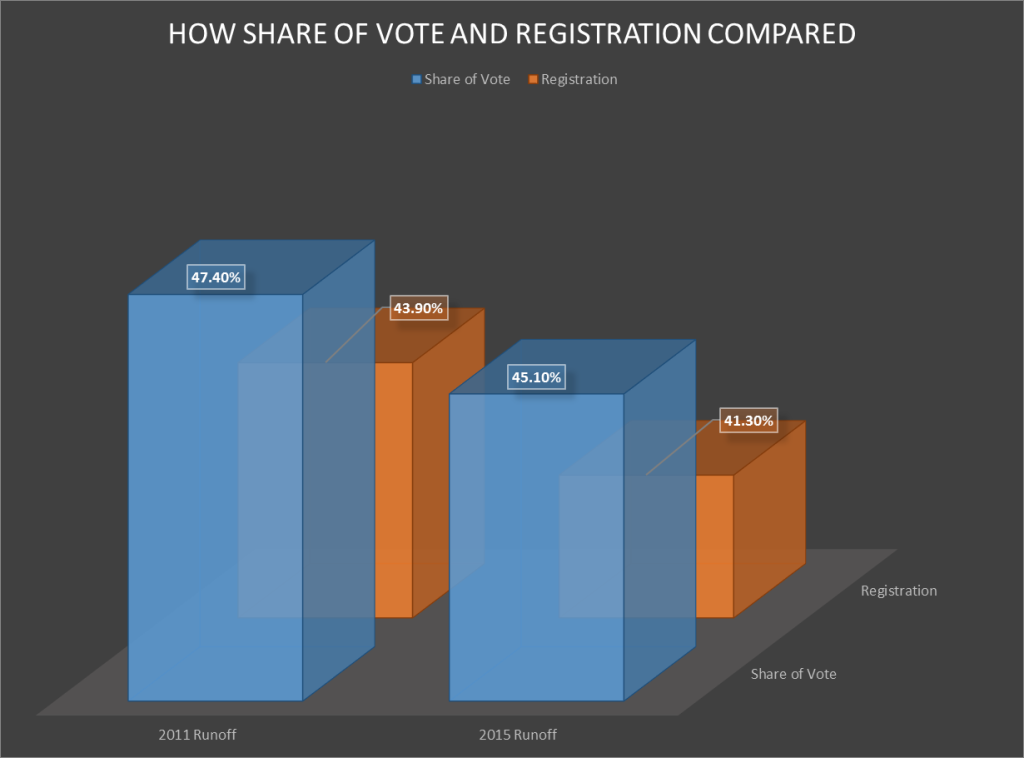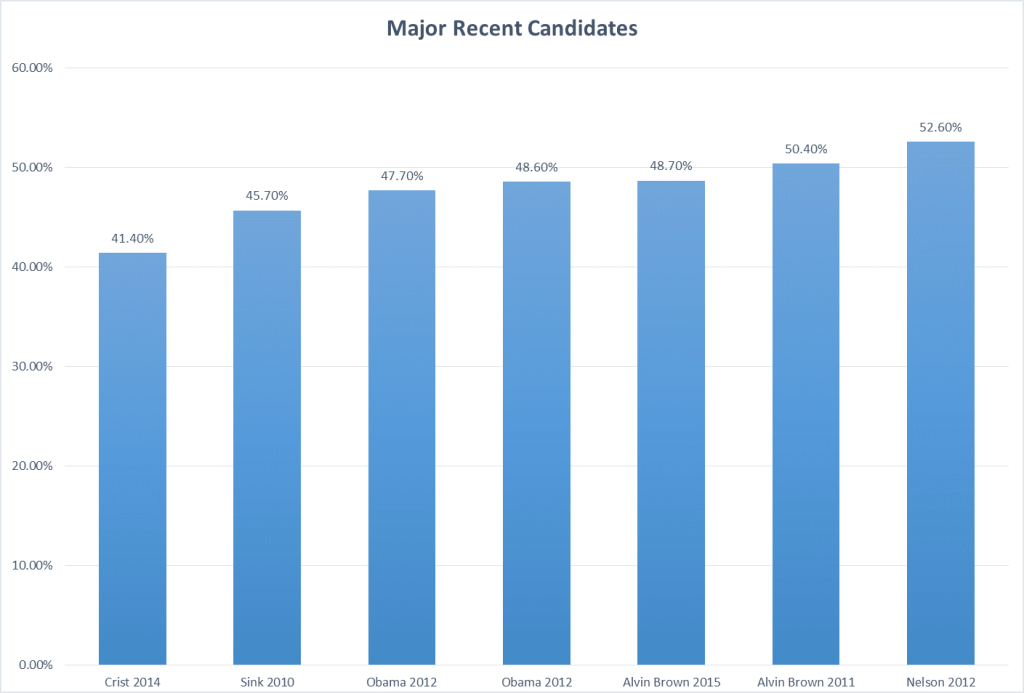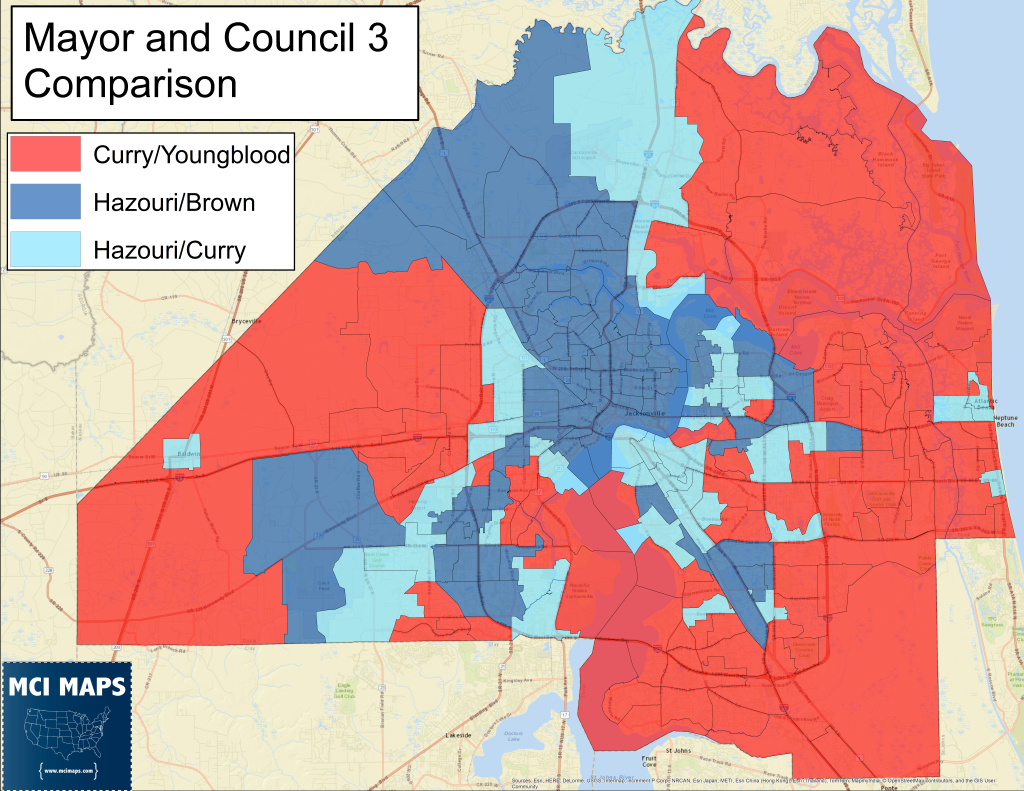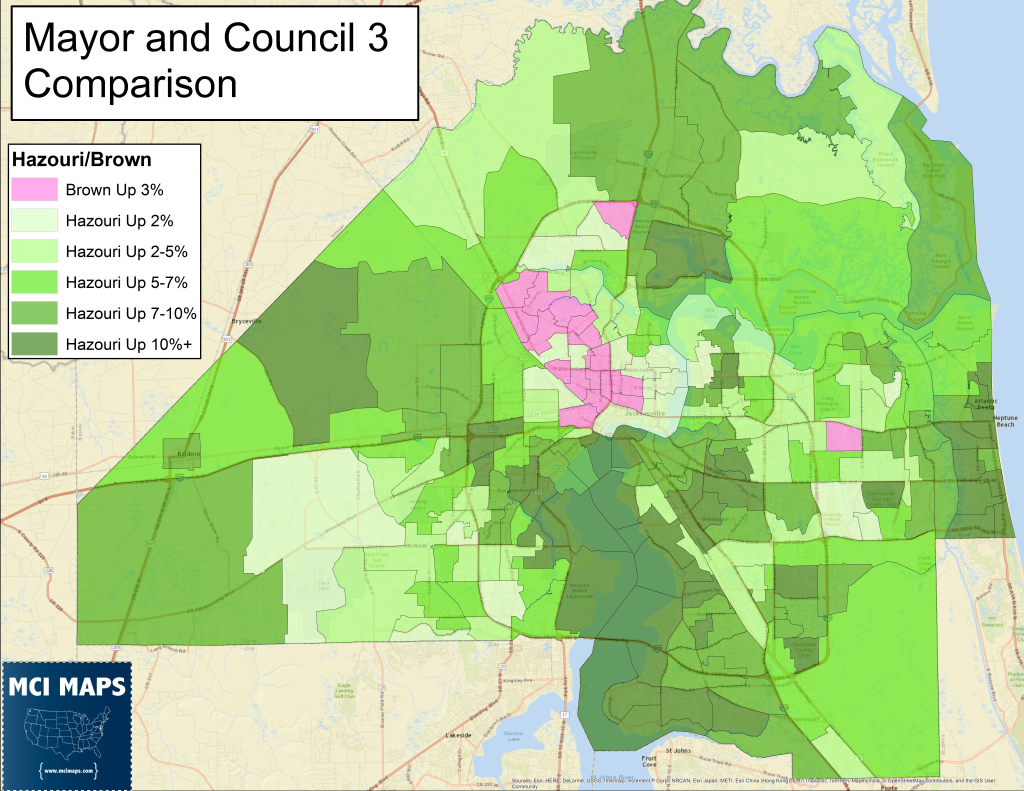The night of the March primary in Jacksonville, I wrote that Alvin Brown had a narrow path to victory. The mayor needed to win over supporters of Bill Bishop, the moderate Republican who came in third place, and he needed to dramatically increase Democratic turnout. When all was said and done on runoff night Alvin Brown narrowly lost re-election with 48.7% of the vote. So what happened?
Bishop Endorsed Brown….kinda
Brown needed Bishop voters to back him. However, once Bishop lost the primary, he opted not to endorse anyone at first. Bishop had many socially-liberal backers that Brown needed to pull off a win, and an endorsement was key to that. Bishop did finally endorse Brown, weeks later, after 24,000 absentee ballots had been returned. a poll days before the election showed Brown getting 42% of Bishop’s supporters while Curry got 46%. If Brown wanted to win with 50% in the first round, he would have needed 44% of Bishop’s supporters. With Bishop backers making a smaller share of the electorate in the runoff (due to increased turnout), Brown would either have needed to win Bishop backers by a larger margin or make the runoff electorate much more Democratic than the March primary electorate. This leads me to point two.
Democratic Turnout Wasn’t High Enough
Over the last week, I was monitoring turnout very closely. Brown had won his election in 2011 thanks to Democrats outpacing Republicans by 10,000+. However, in 2015 the Democratic turnout only outpaced the GOP by just over 3,000. The data below shows how Democrats and Republicans did turnout-wise pre-election day, election day, and total.
Democrats saw the raw vote cast in 2011 fall while the GOP and NPAs saw increases. While Democrats still made up a larger share of the vote, it was not close to what they needed to win. Both the share and raw vote margins were well below what Brown needed them to be. As the 2011 data shows, much of the Democratic advantage came from election day while early/absentee was essentially a wash. However, 2015 saw Democrats do much better in early/mail, while election day was worse. Person-by-person turnout data (which I dont have yet) would likely confirm that many Democrats who voted on election day in 2011 voted early/mail this time, hence the Democrats doing so much better there.
For the last week, I monitored the shifts in partisan turnout daily to see how it shifted. Democrats started off in a hole due to the GOP’s strength with absentee ballots for Duval County. Once early voting began, Democrats narrowed the gap and eventually took the lead. By the end of early voting Sunday, they were at 5,500+ ballots over the Republicans. Election day was critical for Democrats, they still needed a strong showing; which they did not get.
Democrats needed to be 48% of the vote, maybe a bit less depending on how NPAs voted. However, while their share got to 47% by the end of early voting, it fell with election day’s numbers.
When examining the raw vote gap on a daily basis, the numbers showed Democrats making strong gains in the last days of early voting. They stood at a 5,548 margin over the GOP by the end of Monday. Considering Democrats netted 10K over the GOP in 2011 on eday, getting an extra 5K this time was entirely plausible. However, the Democratic margin actually fell on election day.
There is one notable data point that has been overlooked. Democrat’s share of the vote did fall from 2011. However, so did the Democratic registration (as a percent) in the county. NPA voters have surged from 14% to 22% between 2011 and 2015. This meant that for Democrats to get 47% or 48% (optimal since NPAs make up a much smaller share of the votes cast) in terms of share of the vote, they would have had to dramatically outperformed their registration numbers. In 2011, Democrats made up 47.4% of the vote despite only making up 43.9% of the registration. In 2015, Democrats made up 45.1% of the vote while making up 41.3% of the registration.
Democrats outperformed their registration share by 3.5% in 2011. In 2015, they outperformed by 3.8%, so actually higher than before. However, as the numbers/graph show, Democratic registration fell in 2015.
As for the GOP, they were 37% of registration in 2011 and did 5% better (making up 42% of the vote). This year, they were 36% of the vote, and did 7% better (getting to 43% of the vote). So the GOP did even better than the the Democrats at increasing their share compared to registration shifts.
Who is to blame for the loss?
It was frustrating to see the anti-establishment folks instantly jump on the fact that Brown lost. The Florida Squeeze, known for its attacks on the state Democratic Party, already has an article out slamming the party for the loss. The article is wrong for a number of reasons. The most important item is this. It treated the election like Duval is a swing county and that the race was “toss of the coin” type race. Well guess what, its not, and everyone knows it. Duval is a moderate Republican county. Obama aimed to win it in 2008 and 2012, coming up short both times. The only major Democrat to win it (while running statewide) is Bill Nelson. In fact, here is how Brown’s loss tonight stacks up against other major Democratic names.
Brown’s loss actually ranks better than Obama both times, Charlie Crist, and Alex Sink. He only does worse than himself and Nelson. Obama poured resources into the county but still came behind Brown. Brown, meanwhile, was outspent by Lenny Curry by a large margin, anywhere from 3-1 to 2-1.
Does this mean Brown doesn’t share some blame for his loss? No he definitely does. Brown’s acrimonious relationship with liberals, especially the LGBT community, did him no favors. Brown also avoided Obama and Crist in 2012 and 2014, something that did not sit well with many. Most importantly, Brown’s campaign was not as strong as it was in 2011 (you wont find many who don’t agree with that statement). Fault lies with the campaign itself; not the State Party or any other Democratic group. Plenty of blame can lie with the Brown campaign for not working harder to get Democratic turnout up and for allowing the coordination of it’s efforts with other groups/campaigns.
Individual Campaigns Matter
It should be noted that the night was not an overall bad night for Democrats. Tommy Hazouri, the Democrat running for one of the At-Large City Council districts, won with 55% of the vote. The Hazouri campaign had an all-star campaign staff and amazing consultants: including Eric Conrad, Jenny Busby, Karl Bash, Jessica Osborn, and Kevin Cate. These talented folks ensured a Democratic victory county-wide despite the red tilt. Individual campaign’s do…. in fact…. matter.
Equality Florida also backed Hazouri and several other Democrats and Republicans who backed a Human Right’s Ordinance. In fact, with the results all in, HRO backers now have a majority on the city council. Brown’s general opposition to an HRO resulted him not receiving Equality Florida backing/help. Brown’s HRO opposition also hurt him with the business community, which wanted the ordinance passed to improve the county’s image.
Tommy Hazouri’s win compared to Brown’s loss can be seen in these two maps.
Hazouri won all the precinct Brown did and won several others as well. Meanwhile, Brown didn’t win any precincts that Hazouri’s opponent, Geoff Youngblood, won.
Hazouri notably did better than Brown in Riverside and San Marco, liberal/arty regions of the county. Hazouri also did better in the beach communities and in the Mandarin/upper class suburbs region. Meanwhile, Brown did slightly better in some African-American regions, but only by a 2-3% margin. Some of the Republican suburbs that bleed over from Clay County (the Orange Park region) also gave little more vote to Hazouri than Brown. Considering Clay’s lack of elasticity, its not too surprising the margins weren’t much different between Brown and Curry there. However, Hazouri did win several neighborhoods in that general area that Brown lost (areas less influenced by Clay).
Hazouri’s wins and where he did better reflect the strong campaign he ran. I considered it a much better run campaign than Brown’s and the results bare fruit to that belief.
The nature of campaigns also brings up another point to remember about Alvin Brown. His win in 2011 was considered a major upset and his opponent, Mike Hogan, was widely considered to have run a bad campaign. Hogan made many enemies with the business community with his opposition to investing in downtown Jacksonville, causing him to lose endorsements and money. Hogan was also dragged down by Governor Scott, who pulled less popular than Obama at the time of the election. Watching the race in 2011, I knew Brown had run a good campaign, but Hogan had also ran a bad one. Curry’s campaign, imperfect for sure, was not as bad as Hogan’s.
I expect to see blogs jump up and down on the state party with no factual basis for the criticism. We can all expect to see news articles on if this race has any national implications. Honestly I don’t see it. This was a bad campaign losing a race, with Brown still doing better than many past Democratic candidates. If Hillary Clinton pulls similar numbers to Brown, then she will be winning the state of Florida. The GOP should remember that.

